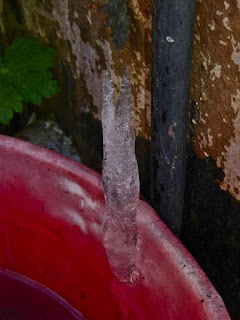Glazing and More Glazing!

Last night saw me finishing packing the electric kiln by 11.20pm after a long day where I started glazing at 6am in the morning. I did have a couple of hours off in the early evening to watch Dr Who with our friend Peter W., whilst some of my glazed pots dried off a bit, but it was a long day.

Laura snapped a couple of photos of me finishing loading the kiln.

I was able to warm the pots gently overnight to drive off moisture from the glazes, and I started the firing properly around breakfast time today. The reason for the rush is that I would like to be able to take some small pots with me to Waitati on Sunday to be with me when I do a throwing demonstration at Gallery On Blueskin there.
I took some photos of pots that were in the last glaze firing in the electric kiln. The firing was to cone ten, well down, and I had some special things in the kiln that people had ordered. There were some chun bowls, some coffee mugs, and a "piggy mug" (well, two actually... just in case!).


The piggy mug was one that someone asked me to do to replace one that she had bought 20 years ago, that had been smashed. She described it to me, but did not have the remains to show me, so I tried my best to come up with something that fitted the description. The tricky bit was that the glaze had to go from a dark brown glaze at the top to a light glaze at the bottom. It also had to have her name on it, and a "piggy" face. I did some test firings of likely glaze combinations, the really important thing being to find glazes that would not move too much when put over each other, as movement would destroy the name which I put on over the lower glaze using wax resist.
Happily, the tests yielded useful results and the glaze firing of the mug went well.
I fired some coffee mugs.


Someone wants a set of 4 coffee mugs to match a mug that I had for sale at the Potter's Co-operative, of which I am a member. The person that ordered a set will be having a look at them tomorrow, so I will know then if they are acceptable.


The chun bowls were to complete a commission for 4 chun bowls that someone ordered from me.
I also fired two bird jugs (Icarus jugs),


a couple of tea pots,


(I had some technical issues with the liner glaze of my large teapot with the handle over the top, the glaze boiled inside the pot, but didn't settle and I will have to re fire the pot. I hope that I might be able to improve the pot somewhat as well, as I find the black glaze on the outside of the pot rather too monotonous.)
and several small bowls.
I tried some pattern experiments with the bowls.


One of my bowls developed a huge blister in the glaze, and will have to be re fired.

The firing was 10 and a half hours from 100 degrees Centigrade. I did a slow climb from about cone 8, taking a full hour from cone 9 starting to show some movement to switching off when cone 11 started to show a slight bend.


My kiln is manual, so I take hourly, or half hourly readings throughout the firing, recording the results on graph paper, and nurse it through the final hour with readings every 5 to 10 minutes. (Good preparation for a wood firing potter!).
I am firing the kiln that I packed last night as I write this. We should be just over 1000 degrees centigrade now.
Post Script. The person that ordered the "piggy mug" was delighted and bought two, the one I made for her and the spare one that I made..., just in case something didn't turn out.


Comments
Seeing your graph makes me happy I have a controller on my kiln. The controller helps me to adjust temps for a slow cool or a preheat.
I think I asked you before - your fire to ^10 ox - so your glazes are all mixed the same to use in your different kilns, right?
Have fun at your demo -- hope you sell a couple of pots, too.
The cone 10 thing is mostly so I can use information gained in the electric firing to give me some clues how a glaze might behave in the wood fired kiln. It is also due to the nature of the local stoneware clay, which needs to be really high fired. I have been playing a bit with clay mixtures to lower the maturing temperature of the clay, but like to support our local clay supplier where at all possible, as it is important to keep him going.